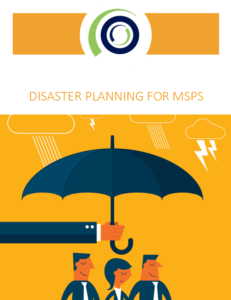Disaster Recovery Planning for MSPs

In the past few months, the southern United States has experienced significant damage from the ravages of hurricanes Harvey and Irma. These natural disasters are freakish and unexpected but unfortunately they are not uncommon. Even at a lesser degree of intensity such as a tropical storm, the results can take the form of significant damages and IT outages.
The question then becomes how to prepare for the unexpected. What are the best practices and tools teams need in order to handle a catastrophe effectively? Leveraging OnPage – Incident Alert Management Platform can be deeply beneficial for MSPs who want to start offering disaster recovery solutions for clients. OnPage can also help MSP teams get disaster recovery ready!
WHO NEEDS A DISASTER RECOVERY PLAN?
Small and medium-sized businesses (SMBs) are becoming increasingly vulnerable to security risks and data loss resulting from malware attacks, DDoS attacks, server failures, and natural disasters. So, what can SMBs do to protect themselves? A good first step is to create a disaster recovery plan, something 75 percent of SMBs don’t currently have in place according to a Nationwide Insurance study. This represents a significant opportunity for MSPs to grow their businesses and create new revenue streams around disaster recovery planning. However, that same Nationwide study found 38 percent of small business owners do not believe it is important to have a disaster recovery plan in place. This statistic indicates that MSPs have their work cut out for them
HOW TO CONVINCE YOUR CUSTOMERS THAT THEY NEED DISASTER RECOVERY PLANNING
Approach your customers with a few key questions that might make them think. Questions like:
- what would happen if they weren’t able to open/operate e-mails
- what would happen if they couldn’t open their app
- what would happen if they couldn’t’ open their website or e-store for an hour or a day
By highlighting the value of Recovery Time Objectives (RTO) and Recovery Point Objectives (RPO), MSPs can help their SMB customers identify how much data they can lose without significantly impacting their business and how long they can go without this data before it hurts their bottom line. It is important to note that if the SMB operates in a highly regulated industry, it will typically need tighter RPOs and RTOs to maintain normal business functions.
SMBs should never underestimate the power of a well-crafted disaster recovery plan, and it is always better for their data to be safe rather than be sorry when it is gone forever. For MSPs, disaster recovery planning can provide a way to add value for their SMB customers, and when they are able to leverage this tool to proactively protect their customers from experiencing a catastrophic loss following a cyber-attack, server failure, or natural disaster, everyone wins.
ONPAGE MAKES YOU READY FOR DISASTER RECOVERY PLANNING
STEP 1 – CATEGORIZE ALERTS: Not all alerts are created equal. As such you need to determine which outages are high priority and which are low priority. This step is essential so that you can prioritize your efforts and make sure you focus on the most important issues first and leave non-critical issues to be handled at a less hectic time. Priorities will change based on the business model at hand so they won’t necessarily be the same for any two businesses.
STEP 2 – ESTABLISH SCHEDULING AND ESCALATION PROTOCOLS: Your IT team needs to have a practiced game plan around who on the team will get alerted and how they will respond. Utilize OnPage’s Digital Scheduler. When disaster strikes, it shouldn’t be a guessing game as to who is notified. There needs to be a pre-defined disaster team who knows that they are the first line of defense, no matter if the technology belongs to their company or to a client. The team and back-up responders need to have their names in a digital schedule so that when an alert comes in, it can be forwarded to the right IT engineer on call right away. Furthermore make sure your alerting policy uses escalations. By implementing escalations, you ensure that if an alert cannot be handled by a particular member of your IT team because they are busy, the alert will be forwarded to the next person in the on-call schedule. In the case of emergencies, this is particularly important.
STEP 3 – ESTABLISH ROCK SOLID COMMUNICATIONS: Communications are perhaps the most important element during a critical outage. If you are unable to communicate with your colleagues or your customers are unable to communicate with you, then the serious outage has just been magnified. Phone lines are easily downed during storms so communications need to occur over smartphones. By using the proper smartphone applications, your team can receive alerts from technologies, customers and colleagues. More importantly, they can use texting capabilities found on smartphone apps like OnPage that mark if a message has been received and read. With this knowledge of a message being read, team members know when their colleagues have received a message or if they need to escalate a request for help.
Read more about the role OnPage plays in helping your team get disaster recovery ready!






